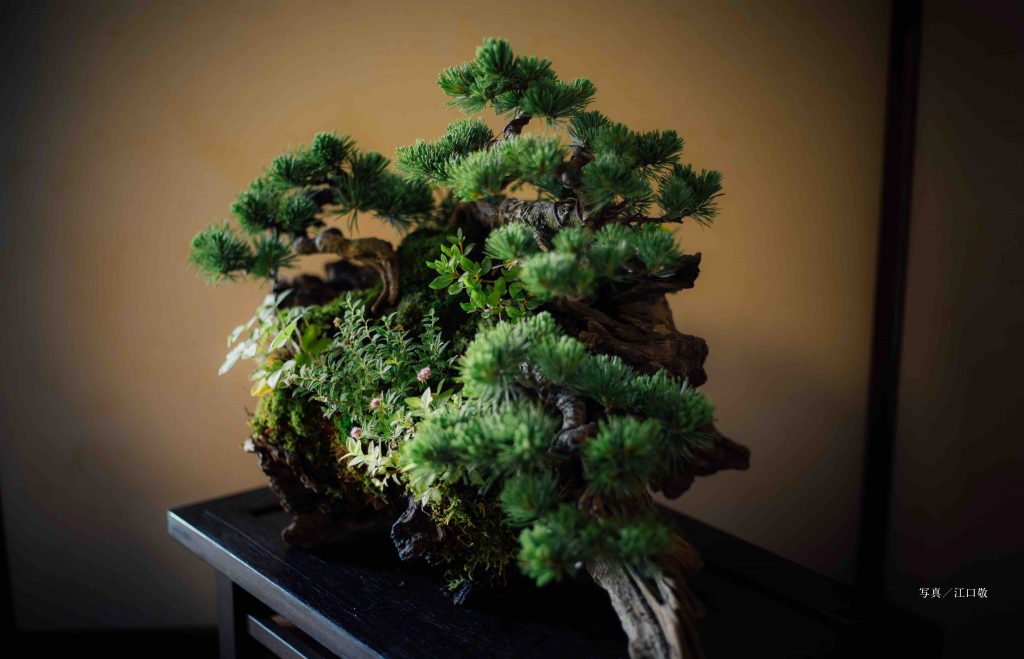※本ワークショップの応募は締め切りました。たくさんのご応募ありがとうございました。
西会津の風景を観察し、そのイメージから実際に盆栽を仕上げていく過程をレクチャーと盆栽制作のデモンストレーションによって披露。海外にも大きな影響を与えた日本を代表する盆栽作家・阿部倉吉の「空間有美」の哲学を見て聴いて学べる講座です。
日時:平成29年7月23日(日)10:30〜16:30
場所:西会津国際芸術村及び西会津町内
講座料:2000円
定員:20名程度
要予約/予約締切7月14日|金|
予約/問い合わせ:西会津国際芸術村 担当 矢部
メール niav.public@gmail.com tel 0241-47-3200
|当日スケジュール|
10:30 集合 西会津国際芸術村
10:30~11:00 講座
11:00~11:30 町内の赤松林に移動
11:30~12:30 現地にてレクチャー
13:00~14:30 各自昼食および移動(晴天時:現地、雨天時:芸術村)
14:30~16:30 盆栽制作デモンストレーション
*昼食(お弁当)は各自ご用意ください。
*予約時には、自家用車の有無をお伝えください。参加人数によっては、
風景レクチャーの現場までは自家用車でご移動頂く場合がございます。
*公共交通機関でお越しの場合には、ご予約時にお伝えください。
アクセス方法などはご予約後にお伝えいたします。
|講師| 盆栽作家・阿部大樹
ぼんさいや「あべ」盆栽作家。祖父である盆栽作家・阿部倉吉が提唱する「空間有美」の哲学を継承し、吾妻山をメインフィールドに、自然や風景と対峙しながら盆栽の創作活動を行っている。
ぼんさいや「あべ」facebook
https://www.facebook.com/kukanyubi/
空間有美について
盆栽というのは、自然流でなければならない。もちろん、自然の木にも見苦しい枝や不要な枝があれば、盆栽として作る場合にはそれを手伝ってやる必要もあるし、なかには、自然に反した無駄な作り方をしなければ鑑賞に堪えられない木もあろう。ただし、技巧を加えても、無理をした場所は枝葉で隠すなどしてその跡を見せないことで、無理のないように作っていかなければならない。
つまり、自然に範をとった無理のない木作りをするには、自然の樹木をよく観察し、それぞれの木が育成する環境、性質、個性を考えていくことが大切である。例えば、盆栽の枝を考察してみても、「この枝はなぜ太くなったのか、このような太い枝はどうすればよいのか」とか、「この枝はなぜ細いのか、このような細い枝はどうすればよいのか」などという疑問に答えてくれるのが、自然樹の枝の付き方なのである。
自然にある野山の木々には、長年の間に日陰になっていた幹や枝は枯れ、日当たりのよい枝が残るなどの淘汰が行われている。すなわち、樹齢を経た老木は、自然にみずからの姿を作っていくのである。松は、古くなればなるほど葉数が多くなり、葉数が多くなるほど、重なり枝(下枝)に日光が当たらなくなるため、幹から出た枝や小枝の込み合っているところが枯れて、そこに空間ができるのが自然であり、一枝ずつが自分の決められた場所で十分な働き(芸)を見せてくれる。これを盆樹の枝作りの参考にしないことは考えられぬであろう。
また、自然樹を手本とした樹形の考察で、どうしても忘れられないのが「空間有美」という言葉である。これは、文字通り空間には美しさがあるということで、自然ならば枝と枝との空間、幹と幹との空間、枝と幹との空間が考えられ、盆樹ではこれに鉢の空間が付け加えられるであろう。盆栽を作っていくには、空間を生かし、空間の表す美しさを表現することが重要なテーマとなる。
枝のハズミや変化もなく、ただ庭木を刈り込んだような、樹冠一面がベッタリと葉で埋まっている盆栽を見たことはないだろうか。これでは、盆栽の見どころである幹模様や枝ぶりも見られない。このような味のない木を見ていると、いかに空間(間)が大切であるかを思い知らされる。
盆栽を作るうえでは、常に空間には美しさがあるということを念頭に置いておかなければならない。
これが「空間有美」という言葉に込められた意味であり、願いでもある。
About ‘Kukanyubi’ (The Beauty of Space)
Bonsai means following the flow of nature. Of course, many natural trees have unsightly or unnecessary branches, and you have to support them when practicing bonsai. When working with these trees, sometimes you have to rely on unnatural techniques to appreciate their aesthetic worth. However, you can use additional techniques to hide the unnatural areas with branches and leaves, and produce trees that do not appear unnatural.
Ultimately, you have to use natural examples to create natural looking trees. It is important to observe nature and consider the environment where the tree grew, the properties of the tree, and its individual characteristics. If you study the branches of a tree, you might ask yourself, “Why did this branch thicken, and what should I do with such a thick branch?” Or “Why is this branch so thin, and what should I do with such a thin branch?” But, it is a naturally occurring shape.
Trees that grow naturally on a hillside have trunks and branches that may wither after spending many years in the shade, and the branches that receive a lot of sun may grow and prosper. That is to say, old trees that have aged naturally produce their own natural shape. As pine trees age, the number of leaves increase, as leaves increase, the heavy lower branches may no longer receive any direct sunlight. The tree begins to wither where the branches join the trunk, or where there is a bunch of small twigs. Space is created naturally, and each individual branch, in its own place, can show its function. This is what you have to think about when you cultivate branches with bonsai.
When you consider a tree’s shape, using a natural tree as a model, you should never forget the phrase ‘kukanyubi’. This translates into English as ‘the beauty of space’. In nature, you can consider the space between branches, between trucks, and between branches and trunks. In bonsai, you can also include the space of the pot. When you produce bonsai, the spaces are alive, and showing the beauty of these spaces is an important theme.
Have you ever seen a bonsai where the canopy is covered in leaves? Where there is no balancing or alteration of the branches, and it is simply pruned like a tree in a garden? You can’t see the form of the trunk or the shape of the branches. If you see such an un-styled tree, you will understand the importance of ‘negative space’.
When cultivating bonsai, you must always keep ‘the beauty of space’ in mind. That is the desire and meaning contained in the phrase ‘kukanyubi’.



